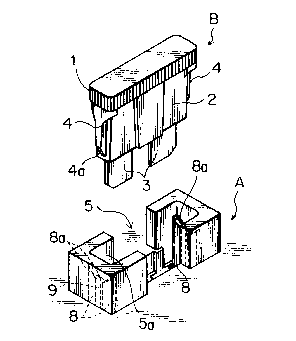Une partie des informations de ce site Web a été fournie par des sources externes. Le gouvernement du Canada n'assume aucune responsabilité concernant la précision, l'actualité ou la fiabilité des informations fournies par les sources externes. Les utilisateurs qui désirent employer cette information devraient consulter directement la source des informations. Le contenu fourni par les sources externes n'est pas assujetti aux exigences sur les langues officielles, la protection des renseignements personnels et l'accessibilité.
L'apparition de différences dans le texte et l'image des Revendications et de l'Abrégé dépend du moment auquel le document est publié. Les textes des Revendications et de l'Abrégé sont affichés :
| (12) Brevet: | (11) CA 2051188 |
|---|---|
| (54) Titre français: | BOITE A FUSIBLES POUR FUSIBLES DU TYPE A LAME |
| (54) Titre anglais: | FUSE BOX FOR BLADE-TYPE FUSE |
| Statut: | Périmé et au-delà du délai pour l’annulation |
| (51) Classification internationale des brevets (CIB): |
|
|---|---|
| (72) Inventeurs : |
|
| (73) Titulaires : |
|
| (71) Demandeurs : |
|
| (74) Agent: | ROBIC AGENCE PI S.E.C./ROBIC IP AGENCY LP |
| (74) Co-agent: | |
| (45) Délivré: | 1996-05-28 |
| (22) Date de dépôt: | 1991-09-11 |
| (41) Mise à la disponibilité du public: | 1992-03-13 |
| Requête d'examen: | 1991-09-11 |
| Licence disponible: | S.O. |
| Cédé au domaine public: | S.O. |
| (25) Langue des documents déposés: | Anglais |
| Traité de coopération en matière de brevets (PCT): | Non |
|---|
| (30) Données de priorité de la demande: | ||||||
|---|---|---|---|---|---|---|
|
A fuse box has a fuse cavity for receiving the
body of a blade type fuse having blade-like male terminals
projecting from the body into an insertion direction of the
blade type fuse. The body of blade type fuse has opposed
ends extending into the insertion direction and a side rib
provided on each of the opposed ends and extending into the
insertion direction. The fuse cavity has opposed walls for
receiving therebetween the opposed ends of the blade type
fuse when the blade type fuse is inserted. The fuse cavity
also has two pairs of second ribs on the opposed walls, each
pair being positioned to define a receiving groove there-
between for receiving the side rib of the blade type fuse.
Note : Les revendications sont présentées dans la langue officielle dans laquelle elles ont été soumises.
Note : Les descriptions sont présentées dans la langue officielle dans laquelle elles ont été soumises.

2024-08-01 : Dans le cadre de la transition vers les Brevets de nouvelle génération (BNG), la base de données sur les brevets canadiens (BDBC) contient désormais un Historique d'événement plus détaillé, qui reproduit le Journal des événements de notre nouvelle solution interne.
Veuillez noter que les événements débutant par « Inactive : » se réfèrent à des événements qui ne sont plus utilisés dans notre nouvelle solution interne.
Pour une meilleure compréhension de l'état de la demande ou brevet qui figure sur cette page, la rubrique Mise en garde , et les descriptions de Brevet , Historique d'événement , Taxes périodiques et Historique des paiements devraient être consultées.
| Description | Date |
|---|---|
| Le délai pour l'annulation est expiré | 2010-09-13 |
| Lettre envoyée | 2009-09-11 |
| Inactive : CIB de MCD | 2006-03-11 |
| Accordé par délivrance | 1996-05-28 |
| Demande publiée (accessible au public) | 1992-03-13 |
| Toutes les exigences pour l'examen - jugée conforme | 1991-09-11 |
| Exigences pour une requête d'examen - jugée conforme | 1991-09-11 |
Il n'y a pas d'historique d'abandonnement
| Type de taxes | Anniversaire | Échéance | Date payée |
|---|---|---|---|
| TM (brevet, 6e anniv.) - générale | 1997-09-11 | 1997-08-07 | |
| TM (brevet, 7e anniv.) - générale | 1998-09-11 | 1998-08-05 | |
| TM (brevet, 8e anniv.) - générale | 1999-09-13 | 1999-07-20 | |
| TM (brevet, 9e anniv.) - générale | 2000-09-11 | 2000-08-16 | |
| TM (brevet, 10e anniv.) - générale | 2001-09-11 | 2001-08-17 | |
| TM (brevet, 11e anniv.) - générale | 2002-09-11 | 2002-08-16 | |
| TM (brevet, 12e anniv.) - générale | 2003-09-11 | 2003-08-21 | |
| TM (brevet, 13e anniv.) - générale | 2004-09-13 | 2004-08-19 | |
| TM (brevet, 14e anniv.) - générale | 2005-09-12 | 2005-08-05 | |
| TM (brevet, 15e anniv.) - générale | 2006-09-11 | 2006-08-08 | |
| TM (brevet, 16e anniv.) - générale | 2007-09-11 | 2007-08-08 | |
| TM (brevet, 17e anniv.) - générale | 2008-09-11 | 2008-08-11 |
Les titulaires actuels et antérieures au dossier sont affichés en ordre alphabétique.
| Titulaires actuels au dossier |
|---|
| YAZAKI CORPORATION |
| Titulaires antérieures au dossier |
|---|
| MAMORU ARAKI |
| MASAAKI SUGIYAMA |